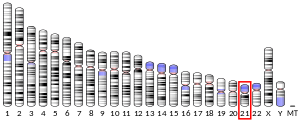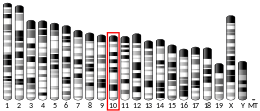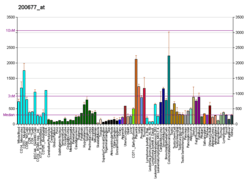PTTG1IP
Pituitary tumor-transforming gene 1 protein-interacting protein (PTTG1), also known as PTTG1-binding factor (PBF), is a poorly characterised protein that in humans is encoded by the PTTG1IP gene [5][6][7] located within the chromosomal region 21q22.3.[8]
Structure
The encoded protein is composed of 180 amino acids and has a predicted molecular mass of 22kDa. The peptide sequence shares no significant homology with any other human proteins but is highly conserved across a wide diversity of animal species, suggesting both unique function and evolutionary importance.[8] Initial protein prediction studies suggested that PTTG1IP was a cell surface glycoprotein, however, the recent identification of a nuclear localisation signal (NLS) suggests that it may have a role both in the cytoplasm and as a nuclear protein.[8]
Function
Although PTTG1IP is ubiquitously expressed in normal human tissues, its exact function remains elusive.[8] It has been shown to directly interact with the human securin and proto-oncogene, PTTG1, thus facilitating its nuclear translocation and the subsequent transcriptional activation of basic fibroblast growth factor (bFGF) by PTTG1.[8]
Further evidence suggests that PTTG1IP may have a direct role in cancer. Initially, PTTG1IP expression was found to be higher in pituitary tumours compared with normal pituitary tissue.[9] In particular, PTTG1IP has been shown to regulate thyroid cell growth, with overexpression resulting in hyperplasia and the formation of lesions within the thyroid gland.[10] PTTG1IP expression has also been independently associated with tumour recurrence [9] and subcutaneous expression results in tumour formation in nude mice.[9]
PTTG1IP is also implicated in breast cancer.[11] Immunohistochemical analysis of tissue samples has revealed that PTTG1IP is strongly expressed in several types and grades of breast cancer.[11] Furthermore, overexpression and secretion of PTTG1IP induces cell invasion,[11] a process that is essential for the formation of metastatic disease.
Furthermore, PTTG1IP has been reported to regulate the expression of the human sodium-iodide symporter (NIS).[12] NIS is expressed by thyroid follicular epithelial cells and is responsible for iodine transport and uptake. The ability of the thyroid to accumulate iodine provides the basis for radioiodine ablation of thyroid tumours and their metastases. Overexpression of PTTG1 or PTTG1IP inhibits NIS mRNA expression and iodide uptake in human and rat thyroid cells.[10][12][13][14] This has important implications for radioiodine ablation therapy and highlights PTTG1IP as a novel target for improving radioiodine uptake by thyroid tumours.
Interactions
PTTG1IP has been shown to interact with:
References
- GRCh38: Ensembl release 89: ENSG00000183255 - Ensembl, May 2017
- GRCm38: Ensembl release 89: ENSMUSG00000009291 - Ensembl, May 2017
- "Human PubMed Reference:". National Center for Biotechnology Information, U.S. National Library of Medicine.
- "Mouse PubMed Reference:". National Center for Biotechnology Information, U.S. National Library of Medicine.
- Yaspo ML, Aaltonen J, Horelli-Kuitunen N, Peltonen L, Lehrach H (June 1998). "Cloning of a novel human putative type Ia integral membrane protein mapping to 21q22.3". Genomics. 49 (1): 133–6. doi:10.1006/geno.1998.5217. PMID 9570958.
- Hattori M, Fujiyama A, Taylor TD, Watanabe H, Yada T, Park HS, Toyoda A, Ishii K, Totoki Y, Choi DK, Groner Y, Soeda E, Ohki M, Takagi T, Sakaki Y, Taudien S, Blechschmidt K, Polley A, Menzel U, Delabar J, Kumpf K, Lehmann R, Patterson D, Reichwald K, Rump A, Schillhabel M, Schudy A, Zimmermann W, Rosenthal A, Kudoh J, Schibuya K, Kawasaki K, Asakawa S, Shintani A, Sasaki T, Nagamine K, Mitsuyama S, Antonarakis SE, Minoshima S, Shimizu N, Nordsiek G, Hornischer K, Brant P, Scharfe M, Schon O, Desario A, Reichelt J, Kauer G, Blocker H, Ramser J, Beck A, Klages S, Hennig S, Riesselmann L, Dagand E, Haaf T, Wehrmeyer S, Borzym K, Gardiner K, Nizetic D, Francis F, Lehrach H, Reinhardt R, Yaspo ML (June 2000). "The DNA sequence of human chromosome 21". Nature. 405 (6784): 311–9. doi:10.1038/35012518. PMID 10830953.
- "Entrez Gene: PTTG1IP pituitary tumor-transforming 1 interacting protein".
- Chien W, Pei L (June 2000). "A novel binding factor facilitates nuclear translocation and transcriptional activation function of the pituitary tumor-transforming gene product". J. Biol. Chem. 275 (25): 19422–7. doi:10.1074/jbc.M910105199. PMID 10781616.
- Stratford AL, Boelaert K, Tannahill LA, Kim DS, Warfield A, Eggo MC, Gittoes NJ, Young LS, Franklyn JA, McCabe CJ (July 2005). "Pituitary tumor transforming gene binding factor: a novel transforming gene in thyroid tumorigenesis". J. Clin. Endocrinol. Metab. 90 (7): 4341–9. doi:10.1210/jc.2005-0523. PMID 15886233.
- Read ML, Lewy GD, Fong JC, Sharma N, Seed RI, Smith VE, Gentilin E, Warfield A, Eggo MC, Knauf JA, Leadbeater WE, Watkinson JC, Franklyn JA, Boelaert K, McCabe CJ (October 2011). "Proto-oncogene PBF/PTTG1IP regulates thyroid cell growth and represses radioiodide treatment". Cancer Res. 71 (19): 6153–64. doi:10.1158/0008-5472.CAN-11-0720. PMC 3184940. PMID 21844185.
- Watkins RJ, Read ML, Smith VE, Sharma N, Reynolds GM, Buckley L, Doig C, Campbell MJ, Lewy G, Eggo MC, Loubiere LS, Franklyn JA, Boelaert K, McCabe CJ (May 2010). "Pituitary tumor transforming gene binding factor: a new gene in breast cancer". Cancer Res. 70 (9): 3739–49. doi:10.1158/0008-5472.CAN-09-3531. PMC 2875163. PMID 20406982.
- Boelaert K, Smith VE, Stratford AL, Kogai T, Tannahill LA, Watkinson JC, Eggo MC, Franklyn JA, McCabe CJ (June 2007). "PTTG and PBF repress the human sodium iodide symporter". Oncogene. 26 (30): 4344–56. doi:10.1038/sj.onc.1210221. PMID 17297475.
- Smith VE, Read ML, Turnell AS, Watkins RJ, Watkinson JC, Lewy GD, Fong JC, James SR, Eggo MC, Boelaert K, Franklyn JA, McCabe CJ (September 2009). "A novel mechanism of sodium iodide symporter repression in differentiated thyroid cancer". J. Cell Sci. 122 (Pt 18): 3393–402. doi:10.1242/jcs.045427. PMC 2736868. PMID 19706688.
- Smith VE, Franklyn JA, McCabe CJ (August 2011). "Expression and function of the novel proto-oncogene PBF in thyroid cancer: a new target for augmenting radioiodine uptake". J. Endocrinol. 210 (2): 157–63. doi:10.1530/JOE-11-0064. PMID 21450804.
- Smith VE, Read ML, Turnell AS, Sharma N, Lewy GD, Fong JC, Seed RI, Kwan P, Ryan G, Mehanna H, Chan SY, Darras VM, Boelaert K, Franklyn JA, McCabe CJ (July 2012). "PTTG-binding factor (PBF) is a novel regulator of the thyroid hormone transporter MCT8". Endocrinology. 153 (7): 3526–36. doi:10.1210/en.2011-2030. PMID 22535767.
Further reading
- Boelaert K, Tannahill LA, Bulmer JN, et al. (2003). "A potential role for PTTG/securin in the developing human fetal brain". FASEB J. 17 (12): 1631–9. doi:10.1096/fj.02-0948com. PMID 12958169.
- Ota T, Suzuki Y, Nishikawa T, et al. (2004). "Complete sequencing and characterization of 21,243 full-length human cDNAs". Nat. Genet. 36 (1): 40–5. doi:10.1038/ng1285. PMID 14702039.
- Tfelt-Hansen J, Yano S, Bandyopadhyay S, et al. (2004). "Expression of pituitary tumor transforming gene (PTTG) and its binding protein in human astrocytes and astrocytoma cells: function and regulation of PTTG in U87 astrocytoma cells". Endocrinology. 145 (9): 4222–31. doi:10.1210/en.2003-1661. PMID 15178645.
- Stock M, Schäfer H, Fliegauf M, Otto F (2005). "Identification of novel genes of the bone-specific transcription factor Runx2". J. Bone Miner. Res. 19 (6): 959–72. doi:10.1359/jbmr.2004.19.6.959. PMID 15190888.
- Boelaert K, Smith VE, Stratford AL, et al. (2007). "PTTG and PBF repress the human sodium iodide symporter". Oncogene. 26 (30): 4344–56. doi:10.1038/sj.onc.1210221. PMID 17297475.




